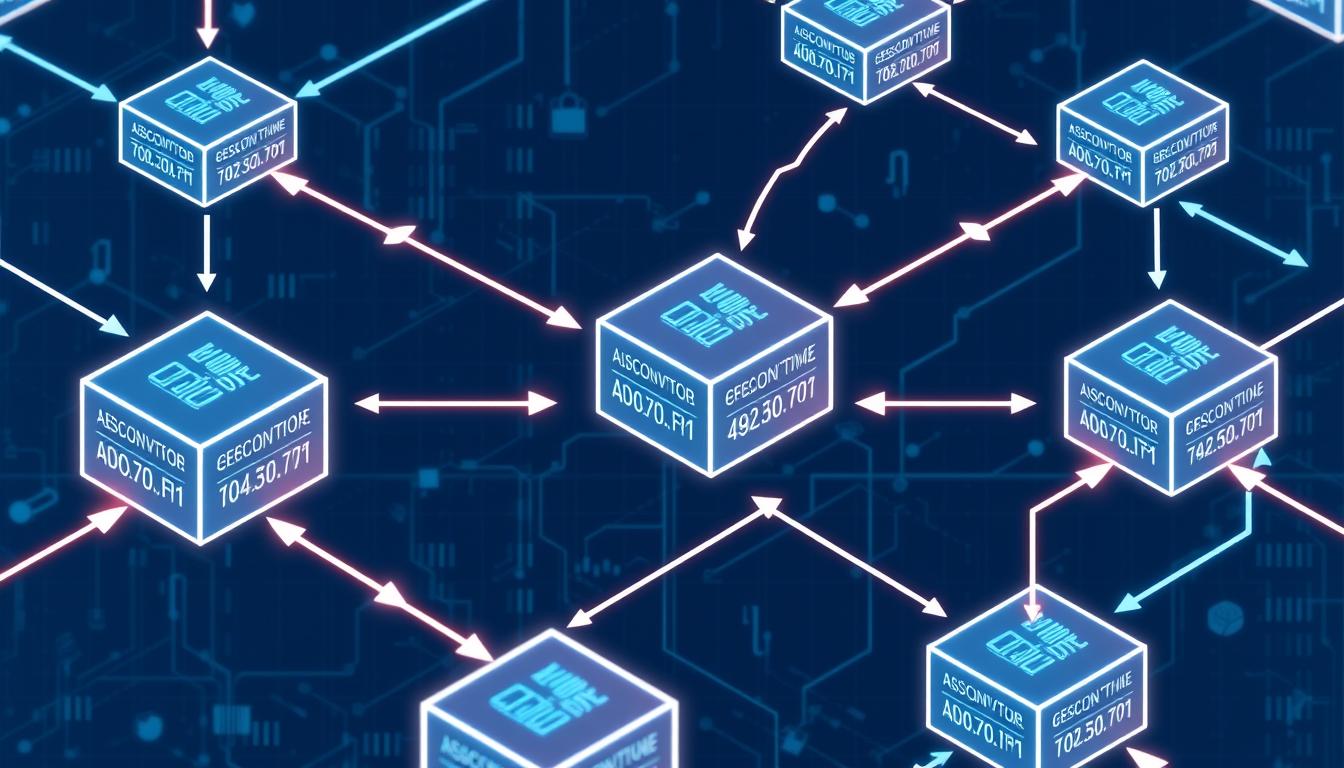Now Reading: Beginner’s Guide to Blockchain: Start Here
- 01
Beginner’s Guide to Blockchain: Start Here
Beginner’s Guide to Blockchain: Start Here

Welcome to our comprehensive beginner’s guide to the world of blockchain technology. If you’re new to the realm of cryptocurrencies, distributed ledger systems, and the innovative applications of blockchain, you’ve come to the right place. In this guide, we’ll explore the fundamentals of blockchain, its core principles, and how it’s transforming various industries and our everyday lives.
Blockchain, often described as the backbone of cryptocurrencies like Bitcoin, is a revolutionary technology that has the potential to disrupt traditional systems and processes across a wide range of sectors. From finance and supply chain management to healthcare and voting systems, blockchain’s decentralized, secure, and transparent nature is paving the way for new and more efficient ways of doing business and managing data.
Whether you’re an entrepreneur, a tech enthusiast, or simply curious about the future of digital technologies, this beginner’s guide will provide you with a solid foundation to navigate the exciting world of blockchain. We’ll cover the basics of how blockchain works, its key components, and the real-world applications that are already shaping our future.
Key Takeaways
- Blockchain is a decentralized, distributed ledger technology that records transactions securely and transparently.
- Blockchain enables the creation of cryptocurrencies, such as Bitcoin, and supports a wide range of applications beyond just finance.
- The core principles of blockchain include decentralization, immutability, and cryptographic security.
- Understanding the fundamentals of blockchain is crucial for navigating the rapidly evolving digital landscape.
- Blockchain technology has the potential to revolutionize industries by streamlining processes, reducing intermediaries, and increasing trust and transparency.
What is Blockchain?
Blockchain is a revolutionary Distributed Ledger Technology that is transforming industries across the globe. At its core, blockchain is a decentralized, digital ledger that records transactions securely and transparently. Unlike traditional centralized databases, blockchain is distributed across a network of computers, known as nodes, that collectively maintain and verify the integrity of the data.
Exploring the Fundamentals of Distributed Ledger Technology
The distributed nature of blockchain is a key feature that sets it apart from conventional record-keeping systems. Each block in the chain contains a set of transactions, and every node in the network has a copy of the entire blockchain. This redundancy ensures that the data is highly resistant to tampering or unauthorized modification, as any changes would need to be verified and approved by the majority of the network.
Understanding Blockchain’s Decentralized Nature
Decentralization is another fundamental principle of blockchain. Unlike traditional systems where a central authority controls the data, blockchain operates on a peer-to-peer network, where participants can interact directly without the need for a intermediary. This decentralized structure eliminates the risk of a single point of failure and enhances the overall security and resilience of the network.
By combining the power of Distributed Ledger Technology and the principles of decentralization, blockchain offers a secure, transparent, and tamper-resistant way to record and manage a wide range of digital transactions, from financial transactions to smart contracts and beyond.
“Blockchain is an incorruptible digital ledger of economic transactions that can be programmed to record not just financial transactions but virtually everything of value.”
– Don Tapscott, author of “Blockchain Revolution”
How Does Blockchain Work?
Understanding the Blockchain Architecture is key to grasping how this revolutionary technology operates. Blockchain Basics revolve around a distributed network of computers, known as nodes, that collectively maintain a comprehensive record of all transactions.
New transactions are grouped into blocks, and these blocks are then chronologically added to the existing chain, creating an immutable and transparent ledger of activities on the network. This process is facilitated by consensus mechanisms, which ensure the integrity and security of the blockchain.
The Fundamentals of Blockchain Architecture
At the core of the Blockchain Architecture are several critical components:
- Blocks – These containers hold batches of valid transactions, forming the backbone of the blockchain.
- Nodes – The distributed computers that make up the network, each maintaining a complete copy of the blockchain.
- Consensus Mechanisms – The protocols that validate new blocks and reach agreement across the network, preventing tampering and ensuring trust.
“Blockchain technology is a decentralized, distributed digital ledger that records transactions across many computers in a network.”
This innovative Blockchain Basics approach ensures the security, transparency, and immutability of the data stored on the network, making it a transformative technology with a wide range of applications.
Beginner’s Guide to Blockchain
Blockchain, the revolutionary technology behind cryptocurrencies like Bitcoin, has been gaining significant attention in recent years. As a beginner, understanding the fundamentals of blockchain is crucial to unlocking its vast potential. In this comprehensive guide, we’ll explore the core principles of this disruptive technology and explain how it differs from traditional databases and financial systems.
At its core, Blockchain Basics is a decentralized, distributed digital ledger that records transactions across many computers in a network. Unlike traditional databases, where data is stored in a centralized location, blockchain data is stored across a network of nodes, making it virtually impossible to tamper with or hack.
One of the key features of blockchain is its immutability. Once a transaction is recorded on the blockchain, it becomes part of the permanent record and cannot be altered or deleted. This ensures the integrity and transparency of the data, making it an invaluable tool for various industries, from finance to supply chain management.
“Blockchain is a technology that has the potential to transform the way we interact with the digital world.”
Another important aspect of Beginner’s Guide to Blockchain is its decentralized nature. Instead of relying on a single authority or intermediary, the blockchain network is maintained by a distributed network of participants, known as nodes. This decentralization enhances security, reduces the risk of single points of failure, and empowers users to have more control over their data.
- Understand the fundamentals of blockchain technology
- Explore the key features that make blockchain unique
- Discover how blockchain differs from traditional databases and financial systems
- Learn about the decentralized nature of blockchain and its implications
By the end of this beginner’s guide, you’ll have a solid understanding of the core principles of blockchain and be well on your way to exploring the vast potential of this transformative technology.
Blockchain and Cryptocurrencies
Cryptocurrency, a revolutionary financial innovation, has been deeply intertwined with the blockchain technology that underpins it. At the forefront of this intersection stands Bitcoin, the pioneering Cryptocurrency that has paved the way for a new era of decentralized digital assets.
Bitcoin: The Pioneering Blockchain-based Cryptocurrency
Unveiled in 2009, Bitcoin was the first Cryptocurrency to leverage the power of blockchain technology. This innovative digital currency operates on a decentralized network, enabling secure and transparent transactions without the need for a central authority. Bitcoin’s blockchain serves as a public ledger, recording all transactions and ensuring the authenticity of the digital assets.
One of the unique features of Bitcoin is its limited supply, which is capped at 21 million coins. This scarcity, combined with the decentralized nature of the network, has contributed to Bitcoin’s growing popularity and value in the Cryptocurrency market. As a result, Bitcoin has become a widely recognized Blockchain Use Case, demonstrating the practical applications of this revolutionary technology.
“Bitcoin is a technological tour de force.” – Bill Gates
The success of Bitcoin has paved the way for the emergence of numerous other Cryptocurrencies, each with its own unique features and use cases. However, Bitcoin remains the most well-known and widely adopted Cryptocurrency, serving as a testament to the transformative power of Blockchain technology in the financial sector.
Smart Contracts and Blockchain
One of the most exciting applications of blockchain technology is the development of smart contracts. Smart contracts are self-executing digital agreements that automatically enforce the terms of a contract without the need for intermediaries. In this section, we’ll explore the concept of smart contracts, how they work on a blockchain network, and the various blockchain use cases where they are being implemented to streamline and automate a wide range of transactions and processes.
At the core of smart contracts is the ability to encode complex contractual terms and conditions into a digital format. These contracts are then stored on the blockchain, ensuring transparency, security, and immutability. When the predetermined conditions are met, the smart contract automatically executes the agreed-upon actions, eliminating the need for manual intervention or centralized authorities.
The applications of smart contracts span a wide range of industries, from finance and real estate to supply chain management and intellectual property rights. For example, in the financial sector, smart contracts can be used to automate loan disbursements, interest payments, and asset trading, reducing the risk of human error and enhancing efficiency.
“Smart contracts have the potential to revolutionize the way we interact and do business, by making transactions more transparent, secure, and efficient.”
In the real estate industry, smart contracts can streamline the property buying and selling process, automating tasks such as title transfers, escrow payments, and rent collection. In the supply chain, smart contracts can track the movement of goods, ensure compliance with regulatory requirements, and trigger automatic payments upon delivery.
As the adoption of blockchain technology continues to grow, the potential for smart contracts to transform various industries is immense. By leveraging the decentralized, transparent, and tamper-resistant nature of the blockchain, smart contracts offer a powerful solution to optimize a wide range of business processes and transactions.
Consensus Mechanisms in Blockchain
Blockchain networks rely on consensus mechanisms to validate and add new transactions to the distributed ledger. These algorithms ensure the integrity of the network by reaching an agreement on the state of the blockchain among the participating nodes. Two of the most prominent consensus mechanisms in the blockchain space are Proof-of-Work (PoW) and Proof-of-Stake (PoS).
Proof-of-Work vs. Proof-of-Stake: Understanding the Differences
Proof-of-Work is the original consensus mechanism pioneered by Bitcoin. In a PoW system, network participants, known as miners, compete to solve complex mathematical problems using computational power. The miner who successfully solves the problem is rewarded with the right to add a new block to the blockchain. This process ensures the security of the network, as it requires a significant amount of energy and resources to carry out a successful attack.
On the other hand, Proof-of-Stake is an alternative consensus mechanism that aims to address the energy-intensive nature of PoW. In a PoS system, the right to validate new blocks is given to users who already hold a certain amount of the blockchain’s native cryptocurrency. These users, known as validators, are responsible for verifying transactions and adding them to the blockchain. The more cryptocurrency a validator holds, the more influence they have in the consensus process.

Both Proof-of-Work and Proof-of-Stake have their own advantages and disadvantages. PoW is known for its robust security, but it can be energy-intensive and slow. PoS, on the other hand, is generally more energy-efficient and can process transactions faster, but it may be more susceptible to centralization concerns. Understanding the differences between these two Consensus Mechanisms is crucial for anyone interested in the world of blockchain technology.
Blockchain Use Cases
As the blockchain technology continues to evolve, its real-world applications are becoming increasingly diverse and transformative. From revolutionizing financial services to enhancing supply chain management, blockchain is making its mark across various industries. Let’s explore some of the most prominent Blockchain Use Cases and Real-World Applications of Blockchain Technology.
Financial Services
One of the most well-known use cases for blockchain is in the financial sector. Blockchain-based cryptocurrencies, such as Bitcoin, have disrupted traditional banking and payment systems, offering faster, more secure, and more transparent transactions. Additionally, blockchain technology is being utilized for digital asset trading, cross-border payments, and innovative financial products like decentralized finance (DeFi).
Supply Chain Management
Blockchain’s ability to provide transparency and traceability has made it a game-changer in the supply chain industry. By recording every step of the supply chain process on a distributed ledger, blockchain can help businesses track the origin, journey, and authenticity of products, reducing the risk of fraud and improving efficiency.
Healthcare
In the healthcare sector, blockchain is being explored for secure storage and sharing of medical records, streamlining of insurance claims, and the development of decentralized clinical trials. The immutable nature of blockchain can help ensure the privacy and integrity of sensitive patient data while enabling seamless collaboration among healthcare providers.
Real Estate
Blockchain technology is transforming the real estate industry by enabling streamlined property transactions, secure record-keeping, and fractional ownership of properties. By digitizing real estate assets and automating certain processes, blockchain can reduce paperwork, increase transparency, and facilitate more efficient real estate investments.
These are just a few examples of the Blockchain Use Cases and Real-World Applications of Blockchain Technology. As the technology continues to mature, we can expect to see even more innovative use cases emerge, revolutionizing various industries and transforming the way we conduct business and daily transactions.
Blockchain Security and Trust
Blockchain technology is revolutionizing the way we think about data security and trust. At the heart of this innovation lies the inherent security features that make blockchain a reliable and trustworthy platform. The distributed nature of the blockchain, combined with cryptographic techniques and consensus mechanisms, ensures the integrity and immutability of data recorded on the ledger, making it resistant to tampering and fraud.
Ensuring Data Integrity and Immutability
One of the key advantages of Blockchain Security is its ability to maintain Data Integrity. Every transaction on the blockchain is validated and recorded in a distributed ledger, which is shared across a network of nodes. This decentralized structure makes it virtually impossible for a single entity to manipulate the data, as any attempt to do so would be immediately detected and rejected by the network.
The Immutability of the blockchain further enhances its security. Once a transaction is recorded on the blockchain, it becomes part of an immutable chain of blocks, each one cryptographically linked to the previous one. This makes it extremely difficult, if not impossible, to alter or delete any information without the consensus of the network, ensuring the integrity of the data over time.
“Blockchain technology offers a level of security and trust that was previously unattainable in the digital world. The combination of decentralization, cryptography, and consensus mechanisms creates a robust and tamper-resistant system, making it an ideal choice for applications that require secure and transparent data management.”
By leveraging these security features, blockchain-based systems can provide a reliable and trustworthy platform for a wide range of applications, from financial transactions to supply chain management and beyond. As the adoption of blockchain technology continues to grow, the trust and confidence it instills will become increasingly valuable in the digital age.
Decentralization: The Core Principle of Blockchain
At the heart of blockchain technology lies the principle of decentralization. Unlike traditional financial and data management systems that rely on centralized authorities, blockchain networks are designed to be decentralized, with multiple nodes (computers) working together to maintain the integrity of the digital ledger.
The decentralized nature of blockchain is a key driver of its advantages. By eliminating the need for a central intermediary, blockchain technology promotes transparency, resilience, and the democratization of data and transactions. This decentralized approach ensures that no single entity can control or manipulate the network, fostering a more equitable and secure system for all participants.
One of the core blockchain principles is the concept of distributed consensus, where the network collectively validates and records transactions. This process, known as consensus mechanisms, ensures that the ledger remains tamper-resistant and that all participants have a shared, secure, and up-to-date record of the data.
By embracing decentralization, blockchain technology empowers individuals and organizations to take control of their data, transactions, and interactions. This shift away from centralized control paves the way for innovative applications, improved data security, and the democratization of various industries, from finance to supply chain management.
“The true promise of blockchain lies in its ability to decentralize power and enable a more equitable distribution of resources and opportunities.”
As the adoption of blockchain technology continues to grow, the principle of decentralization remains at the forefront, shaping the future of secure, transparent, and democratized digital ecosystems.
Popular Blockchain Platforms
As the blockchain technology continues to evolve, a diverse array of platforms and ecosystems have emerged, each offering unique features and capabilities. Among the most prominent players in the blockchain landscape are Ethereum, Hyperledger, and a host of other innovative platforms.
Ethereum: The Programmable Blockchain
Ethereum, a decentralized, open-source blockchain platform, has emerged as a leading contender in the blockchain space. Powered by its native cryptocurrency, Ether, Ethereum’s key strength lies in its ability to support smart contracts and decentralized applications (dApps), making it a versatile platform for a wide range of use cases.
Hyperledger: Enterprise-Grade Blockchain Solutions
Hyperledger, a collaborative effort hosted by the Linux Foundation, is a family of blockchain platforms designed for enterprise-level applications. Hyperledger offers a range of tools and frameworks, including Hyperledger Fabric, Hyperledger Sawtooth, and Hyperledger Besu, catering to the specific needs of businesses and organizations seeking to leverage blockchain technology.
While Ethereum and Hyperledger are among the most prominent blockchain platforms, the ecosystem is constantly evolving, with other innovative platforms such as Cardano, Polkadot, and Solana gaining traction in various industries and use cases. Each platform offers its unique strengths, governance models, and community support, making the selection of the right blockchain platform a critical decision for businesses and developers.
Challenges and Limitations of Blockchain
While blockchain technology offers tremendous potential, it also faces several Blockchain Challenges that must be addressed. One of the primary issues is scalability. The current blockchain networks can handle only a limited number of transactions per second, making them unsuitable for large-scale applications. The energy-intensive nature of some consensus mechanisms, such as Proof-of-Work, also raises concerns about the Blockchain Limitations in terms of environmental sustainability.
Another challenge is the regulatory uncertainty surrounding blockchain technology. Governments and policymakers are still grappling with how to effectively regulate this emerging field, creating a level of uncertainty that can hinder mainstream adoption. Additionally, the need for user-friendly interfaces and better interoperability between different blockchain platforms is crucial for driving widespread adoption among both businesses and individuals.
- Scalability limitations
- High energy consumption
- Regulatory uncertainty
- Lack of user-friendly interfaces
- Interoperability challenges
Despite these challenges, the blockchain community and developers are actively working to overcome these hurdles and unlock the full potential of this transformative technology. Innovations in areas such as sharding, off-chain scaling solutions, and alternative consensus mechanisms are paving the way for a more scalable and sustainable blockchain ecosystem.
“Blockchain technology is still in its early stages, and overcoming the current limitations will be crucial for its widespread adoption.”
The Future of Blockchain Technology
As the Future of Blockchain technology continues to unfold, we’re witnessing a remarkable evolution in the blockchain ecosystem. From the rise of Blockchain Trends like decentralized finance (DeFi) to the transformative impact of non-fungible tokens (NFTs), the potential of this transformative technology is only just beginning to be realized.
One of the most exciting Blockchain Trends is the integration of blockchain with other emerging technologies, such as artificial intelligence (AI) and the Internet of Things (IoT). This convergence promises to unlock new use cases and drive innovation across various industries, from supply chain management to smart cities. As these technologies converge, we can expect to see even more seamless and secure data sharing, enhanced decision-making, and the creation of truly decentralized ecosystems.
Furthermore, the Future of Blockchain holds significant implications for the broader societal and economic landscape. As blockchain-based platforms continue to gain traction, we may witness the rise of new business models, the disruption of traditional industries, and the empowerment of individuals through decentralized governance and ownership models. The potential for blockchain to enhance transparency, traceability, and trust across a wide range of applications is truly remarkable.
As the Future of Blockchain unfolds, it’s clear that this technology will continue to shape the way we interact, transact, and collaborate in the digital age. By embracing the Blockchain Trends and exploring the emerging possibilities, we can harness the power of this transformative technology to create a more equitable, secure, and interconnected world.

“The Future of Blockchain is not just about the technology itself, but the profound impact it can have on the way we live, work, and interact with one another.”
Embracing the Future
As we look ahead, the Future of Blockchain technology holds immense promise. By staying informed about the latest Blockchain Trends and actively exploring the potential applications of this transformative technology, we can position ourselves to capitalize on the opportunities it presents and contribute to the shaping of a more decentralized, transparent, and equitable future.
Getting Started with Blockchain
Are you eager to dive into the world of blockchain technology? Whether you’re a curious beginner or looking to explore new opportunities, this section will provide you with practical steps to get started on your blockchain journey. Let’s navigate the fascinating landscape of this transformative technology together.
First and foremost, the best way to get started with blockchain is to educate yourself. Explore online courses, attend industry events, and immerse yourself in reputable websites and publications. Building a solid foundation will equip you with the knowledge to navigate this dynamic field.
- Enroll in online blockchain courses to gain a comprehensive understanding of the technology, its applications, and best practices.
- Attend local or virtual blockchain meetups, conferences, and workshops to connect with the community, learn from experts, and stay up-to-date with the latest trends.
- Subscribe to newsletters, podcasts, and industry-leading blogs to keep abreast of the latest developments in the blockchain ecosystem.
Once you’ve laid the groundwork, consider engaging with the blockchain community. Participate in online forums, join social media groups, and connect with professionals in the industry. These interactions will provide valuable insights and opportunities to explore potential collaborations or career paths in the Getting Started with Blockchain space.
“Blockchain has the potential to fundamentally change the way we think about trust, transparency, and the exchange of value.”
As you deepen your understanding of blockchain, consider exploring opportunities to work or invest in this burgeoning field. From software development and consultancy to cryptocurrency trading and initial coin offerings (ICOs), the blockchain industry offers a diverse range of possibilities. Carefully research and evaluate any potential ventures to ensure they align with your goals and risk tolerance.
Remember, the world of blockchain is continuously evolving, so it’s crucial to stay curious, adaptable, and open-minded. By taking the first steps and immersing yourself in this dynamic ecosystem, you’ll be well on your way to becoming a blockchain enthusiast and potentially shaping the future of this transformative technology.
Conclusion
In this comprehensive Beginner’s Guide to Blockchain, we’ve explored the fundamental aspects of this transformative technology. From understanding the core principles of distributed ledger technology to delving into the world of Blockchain Basics, this guide has provided you with a solid foundation to navigate the exciting realm of blockchain.
Throughout this journey, we’ve witnessed how blockchain has the power to disrupt a wide range of industries, from finance to supply chain management. As the technology continues to evolve, it’s crucial for individuals and businesses to recognize its capabilities and learn how to leverage them effectively.
We hope this guide has equipped you with the knowledge and insights necessary to embark on your blockchain exploration. By understanding the fundamentals, you’ll be better positioned to identify the opportunities and challenges that lie ahead, and to contribute to the ongoing advancements in this transformative field.
FAQ
What is blockchain technology?
Blockchain is a decentralized, distributed digital ledger that records transactions across many computers in a network. It is the underlying technology that enables the development of cryptocurrencies, smart contracts, and a wide range of innovative applications.
How does blockchain work?
Blockchain operates on a distributed network of computers, where each node (computer) maintains a copy of the entire transaction history. New transactions are grouped into blocks, and these blocks are then added to the chain in a chronological order, creating an immutable and transparent record of all activities on the network.
What are the key features of blockchain technology?
The key features of blockchain technology include decentralization, transparency, immutability, and security. The distributed nature of the blockchain ensures that there is no single point of failure, and the cryptographic techniques and consensus mechanisms used in the network help maintain the integrity and trustworthiness of the data recorded on the ledger.
What is the difference between blockchain and traditional databases?
The main difference between blockchain and traditional databases is the decentralized and distributed nature of the blockchain. While traditional databases are centralized and controlled by a single entity, blockchain networks are decentralized, with multiple nodes (computers) working together to maintain the integrity of the ledger. This makes blockchain more transparent, secure, and resistant to tampering or fraud.
What are the common consensus mechanisms used in blockchain networks?
The two most common consensus mechanisms used in blockchain networks are Proof-of-Work (PoW) and Proof-of-Stake (PoS). PoW relies on miners to solve complex computational problems to validate transactions and add new blocks to the chain, while PoS uses the amount of cryptocurrency held by validators to determine their voting power and participation in the consensus process.
What are some of the real-world applications of blockchain technology?
Blockchain technology has a wide range of applications across various industries, including finance (e.g., cryptocurrencies, decentralized finance), supply chain management, healthcare, real estate, voting systems, and more. Blockchain can improve transparency, traceability, and efficiency in these sectors by enabling secure, decentralized, and tamper-resistant record-keeping.
What are the challenges and limitations of blockchain technology?
Some of the key challenges and limitations of blockchain technology include scalability, energy consumption, regulatory uncertainty, and the need for user-friendly interfaces. The blockchain community and developers are continuously working to address these issues and unlock the full potential of this transformative technology.
What is the future of blockchain technology?
The future of blockchain technology is promising, with emerging trends and potential developments in areas such as decentralized finance (DeFi), non-fungible tokens (NFTs), and the integration of blockchain with other emerging technologies (e.g., artificial intelligence, the Internet of Things). As the technology continues to evolve, it is expected to have a significant impact on various industries and sectors, transforming the way we conduct transactions and manage data.
How can I get started with learning about blockchain?
To get started with learning about blockchain, you can explore online courses, industry events, and reputable websites and publications. Engaging with the blockchain community, staying up-to-date with the latest developments, and potentially exploring opportunities to work or invest in the blockchain ecosystem can also help you deepen your understanding of this transformative technology.














